Brightspace Learning Environment
Assignments - Create and edit experience | New
The create and edit Assignments page has an updated look and feel. The classic tabbed view has been transformed into a new, fully immersive page layout.
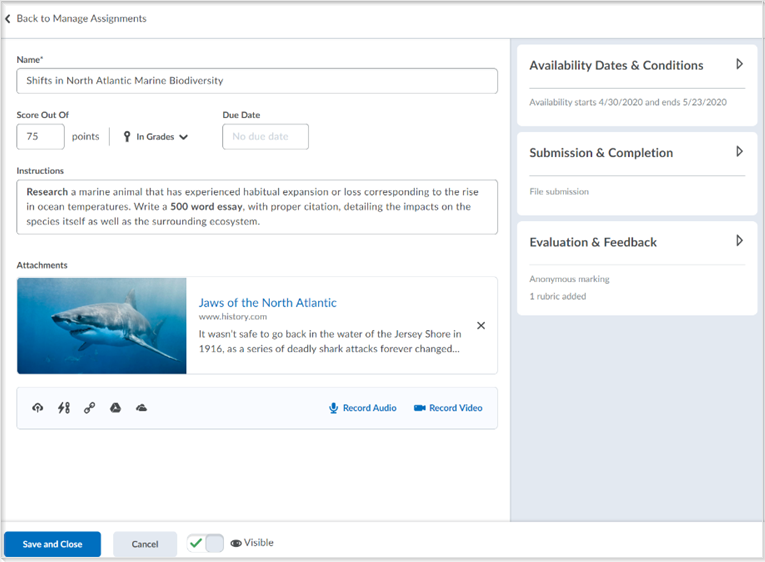
Figure: The updated look and feel of the new Assignment creation screen
The primary panel on the left contains frequently used fields that are always displayed. These fields are most relevant to learners and are the core details instructors want to add; a due date, instructions, and attachments.
The panel on the right organizes additional, more advanced options such as start and end dates, rubrics, annotation tools, and Turnitin. When these options are collapsed, summary text provides details about which settings are active and subtle hints that aid in the discovery of additional settings. As a result, you can see everything at a glance with little to no scrolling, and without having to navigate through any tabs.
The new experience streamlines the process of linking assignments to your gradebook and builds on a pattern first introduced in Activity Feed. When you enter a score, your assignment is added to Grades, and the name and score are automatically synced for you. If you traditionally create grade items in advance, support for selecting existing grades and categories is also available.
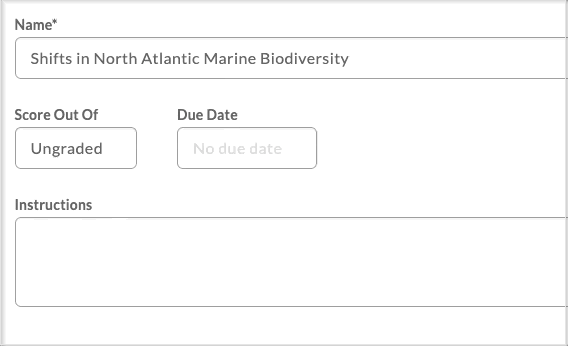
Figure: The new add to grades workflow
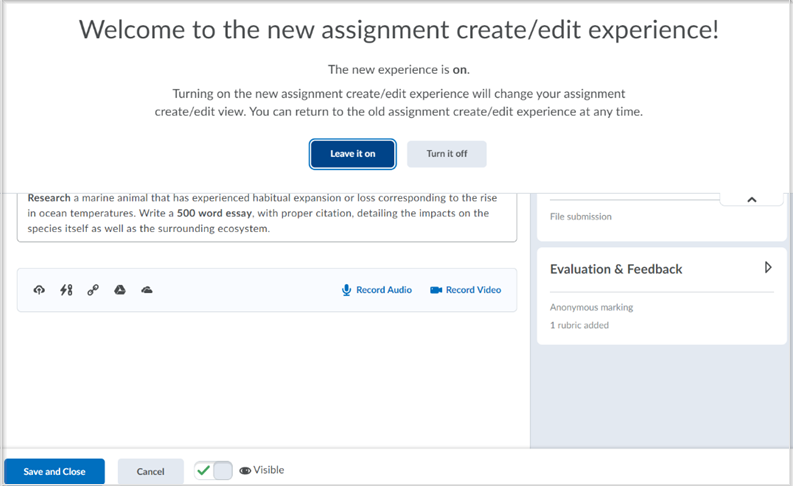
Figure: The new assignment create/edit page with the opt-in/opt-out pull down menu
As an Instructor, if you are opting out of the new experience, a prompt appears encouraging you to leave feedback on the new experience.
| Impact of Change | Technical Details |
|---|---|
| Slight impact to Administrators due to the configuration variable that grants the ability for instructors to opt-in to the new assignment create/edit experience. |
Availability: This feature is available to all clients. To enable: The new assignment creation experience is disabled by default. To enable the new experience, set the d2l.Tools.Dropbox.CreateExperienceOptIn (OrgUnit) configuration variable to On (Opt-In). Instructors may opt into or out of the new assignment creation experience within a specific course at any time. If the new assignment creation experience is set as Off or On, instructors cannot control their use of the feature:
|
|
Large impact to instructors due to the new create and edit assignments experience that they can opt into or out of within a specific course at any given time. |
N/A |
Data Hub - Additions to Brightspace Data Sets | New
To increase the value of the Data Hub offering, this release adds the new ResultId column to allow for more detailed Release Condition reporting. This column enables more data sets to be joined with the Release Condition data sets to understand which objects are released when a condition is met. ResultId has been added to the following Brightspace Data Sets:
- Discussion Forums
- Discussion Topics
- Checklist Objects
- Assignment Summary
| Impact of Change | Technical Details |
|---|---|
|
Moderate impact to administrators due to the addition of new columns. |
Availability: This feature is available to Brightspace Insights and Brightspace Core clients in the following regions: North America, EMEA, and APAC. To enable: Ensure the Can Access Brightspace Data Sets permission is granted to administrators at the org level. New data sets appear the first time the data set runs after the CD update. You must also ensure the d2l.Tools.BrightspaceDataSets.Version configuration variable is set to version 4 or 5. |
Data Hub - Data generation schedule for non-production sites | Update
This feature adds value to non-production sites by generating Brightspace Data Sets (BDS) FULL and DIFF files immediately following each continuous delivery update. This provides a consistent time for users to validate and test any data set changes before these changes are applied to their production environment. For users with other schedules for BDS on their non-prod site today, those will not be modified at this time.
| Impact of Change | Technical Details |
|---|---|
|
Large impact to administrators due to ability to pull fresh BDS data inclusive of changes associated with a release immediately following their CD update on non-prod for review and consideration. |
Availability: This feature is available to Brightspace Insights and Brightspace Core clients in the following regions: North America, EMEA, and APAC. To enable: Ensure the Can Access Brightspace Data Sets permission is granted to administrators at the org level. You must also ensure the d2l.Tools.BrightspaceDataSets.Version configuration variable is set to version 4 or 5. |
Data Hub - Removed Brightspace Data Sets Quiz Questions and Survey Questions | Update
To increase the value of the Data Hub offering, this release removes Quiz Questions and Survey Questions Brightspace Data Sets (BDS) for all clients regardless of BDS version. Over 6 months ago, we introduced two new data sets (Question Library and Question Relationship) in order to improve the way we put together quiz and survey data to include question pools. These new data sets have replaced the need for Quiz Questions and Survey Questions.
For more details about how to use the new data sets instead of Quiz Questions and Survey Questions, refer to this blog post: This WILL be on the quiz: Enhancements to Quiz and Survey data in Brightspace Data Sets.
| Impact of Change | Technical Details |
|---|---|
|
Large impact to administrators due to the removed data sets, which may require a shift to using new data sets. |
Availability: This feature is available to Brightspace Insights and Brightspace Core clients in the following regions: North America, EMEA, and APAC. To enable: Ensure the Can Access Brightspace Data Sets permission is granted to administrators at the org level. Old data sets are deprecated the first time the data set runs after the CD update. You must also ensure the d2l.Tools.BrightspaceDataSets.Version configuration variable is set to version 4 or 5. |
Data Hub - Virtual Classroom Usage Brightspace Data Set | New
To increase the value of the Data Hub offering, this release adds a new partner Brightspace Data Set, Virtual Classroom Usage, which reports on how Virtual Classroom by Bongo is being used. The data set is available to customers with the Premium version of Bongo. It generates as a weekly full and does not include a differential.
| Impact of Change | Technical Details |
|---|---|
|
Slight impact to administrators due to the addition of a new partner data set.
|
Availability: This feature is available to all clients with Bongo Premium in the following regions: North America, EMEA, and APAC. To enable: Ensure the Can Access Brightspace Data Sets permission is granted to administrators at the org level. New data sets appear the first time the data set runs after the CD update. You must also ensure the d2l.Tools.BrightspaceDataSets.Version configuration variable is set to version 4 or 5. |
Discover – Interface improvements to course tiles | New
To allow learners to more easily view information about the courses they may want to self-enroll in, course tiles in the Discover landing page contain some interface improvements. Course tiles are now taller and less wide, course information text is centered, and course icons and text display. These improvements also provide a more consistent look and feel with the overall Brightspace interface.

Figure: Previous design of course tiles in Discover
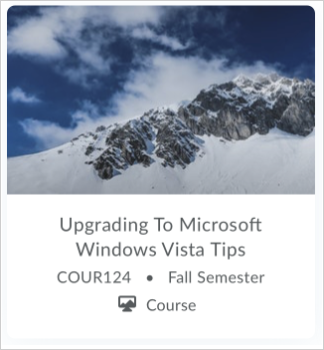
Figure: New design of course tiles in Discover
| Impact of Change | Technical Details |
|---|---|
|
No impact to administrators. |
Availability: This feature is available to Brightspace Core clients in all regions, except Singapore. Clients in Singapore can use Discover; however, data is not stored in the Singapore region. To enable: Ensure that Discover is turned on in Organization Tools. Note: Although Discover appears for all clients, only Brightspace Core clients can turn it on. To display form elements for self-enrollment, navigate to Admin Tools > Form Elements. Under CourseOfferingInfo, enable isDisplayed for Registration and Description. Edit the d2l.System.Enrollment.LearnerRole configuration variable at the organization level. Click Add Value, and then specify an Org Unit ID and select the learner role as the Role value. To allow course administrators or instructors to configure courses for self-enrollment, ensure the course administrator or instructor role has the new Discover > Change Visibility in Discover permission set at the organization level. To allow learners to access Discover, ensure the learner role has the new Discover > Access Discover permission set at the organization level. Add Discover to the navbar. |
| No impact to instructors. |
To configure a course for self-enrollment, navigate to the course and select Course Admin > Course Offering Information. Under Discover, check the Make this course available in Discover so Learners can self-enroll option. Under Description, include a course description to appear in Discover. Ensure that the Course is active option is checked. Click Save. Note: It may take a minute before the course appears in Discover search results. Learners can enroll in a course prior to its Start Date (if configured), but they cannot enroll in a course past its End Date (if configured). |
| Slight impact to learners due to user interface changes in Discover. | N/A |
Discover – Sections for new and updated courses | New
To allow learners to easily distinguish between new and updated courses in Discover, the Discover landing page now divides courses into two sections:
- The New section includes courses added to Discover within the last 6 months. By default, the 4 most recently added courses display. To display all courses added to Discover within the last 6 months, click View All.
- The Updated section includes courses updated within the last 6 months. By default, the 4 most recently updated courses display. To display all courses updated within the last 6 months, click View All.
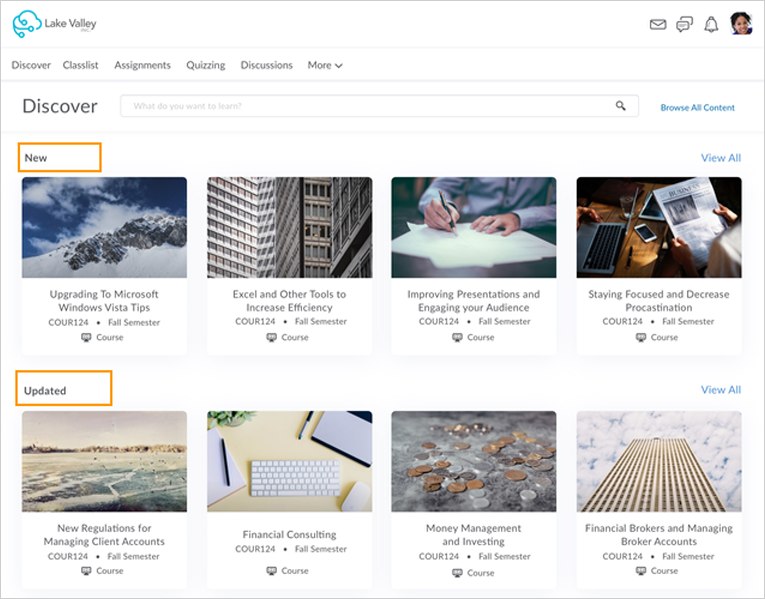
Figure: The New and Updated sections in the Discover landing page
| Impact of Change | Technical Details |
|---|---|
|
No impact to administrators. |
Availability: This feature is available to Brightspace Core clients in all regions, except Singapore. Clients in Singapore can use Discover; however, data is not stored in the Singapore region. To enable: Ensure that Discover is turned on in Organization Tools. Note: Although Discover appears for all clients, only Brightspace Core clients can turn it on. To display form elements for self-enrollment, navigate to Admin Tools > Form Elements. Under CourseOfferingInfo, enable isDisplayed for Registration and Description. Edit the d2l.System.Enrollment.LearnerRole configuration variable at the organization level. Click Add Value, and then specify an Org Unit ID and select the learner role as the Role value. To allow course administrators or instructors to configure courses for self-enrollment, ensure the course administrator or instructor role has the new Discover > Change Visibility in Discover permission set at the organization level. To allow learners to access Discover, ensure the learner role has the new Discover > Access Discover permission set at the organization level. Add Discover to the navbar. |
| Slight impact to learners due to interface improvements in the Discover landing page. | The New section includes courses added to Discover within the last 6 months, not courses added to Brightspace Learning Environment within the last 6 months. With this distinction, it is possible that new courses in Discover may have existed in Brightspace Learning Environment a longer time prior to being added to Discover. |
Learning Outcomes - Detach copied Learning Outcomes from the originating course | New
The default behavior for copying outcomes is to remain linked to the course from which they were copied. If you want to edit the target course, the outcomes must be detached, either individually, or in bulk. To solve this issue, the copied objects must be unlinked in the target course to be editable. When custom created learning outcomes are detached from the source course, they become their own object. This is useful in a scenario when you want to create an update to a master course shell or to teach a new course based on another course with similar but not identical outcomes.
Note: This feature does not apply to Achievement Standards Network (ASN) or Program-imported outcomes.
A warning message appears when you start this action to confirm that you intend to detach locally authored outcomes from the source, and that there is no undoing this function.
When the detach function is performed, all the aligned outcomes in the course are collected. For each outcome that references back to the source, a new outcome is created to replace the linked original. All reference links to the original linked object are updated with the object ID of the new outcome object.
Use the Import/Export/Copy Components tool to copy one or more learning outcomes from a source to a target course. Then, in the target course, in the Standards tool, select one or more outcomes to detach from the source course.
| Impact of Change | Technical Details |
|---|---|
|
Moderate impact to administrators who want to edit learning outcomes in copied courses by detaching either individually or in bulk. |
Availability: This feature is available to all clients using the Learning Outcomes tool. To enable: This functionality is automatically enabled for Learning Outcomes users. No further action is required. |
| Moderate impact to instructors who may or may not be able to edit learning outcomes in their local course depending on whether the outcomes are linked to the originating course. | N/A |
Learning Outcomes - Display of outcome hierarchy and search in Quiz alignment picker | Update
To increase the value of the Learning Outcomes features in the Quiz tool, the learning outcomes hierarchy tree is now displayed. It can be collapsed to facilitate finding and using specific outcomes in any assessment activity or rubric where outcomes can be aligned.
From the Learning Outcomes list, the user can click on the highest-level outcomes to expand and reveal the child nodes within that outcome. Within the child nodes, administrators and instructors can select one or more leaf-node outcomes to align to their course activity or content page. Selecting any parent level of the hierarchy collapses all child objects under that parent.
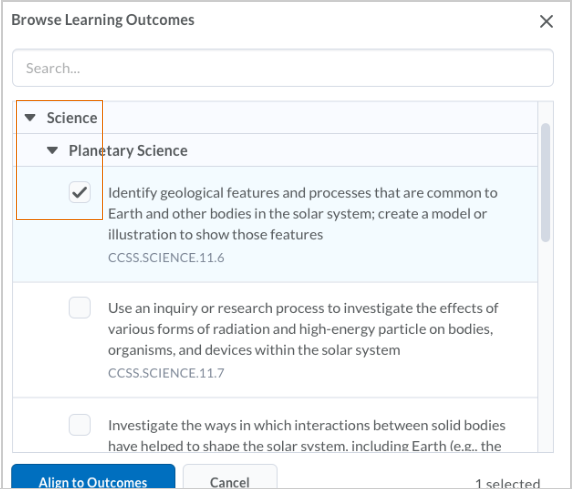
Figure: The expanded hierarchy of the Learning Outcomes picker. The number of hierarchy levels displayed will depend on the outcome structure included in the course intent list.
In addition, users can now search the outcomes list to find the best outcome to align with quiz activities in their courses and programs. If there is a large list of outcomes available for a program or course, the ability to search can save time and provide a better customer experience. When aligning an activity to an outcome in quizzes, users can enter text or an outcome code in the search bar. The search results include outcome descriptions and codes and highlight the search query words in the results.

Figure: The Search bar appears in any assessment activity or rubric where outcomes can be aligned.
This feature was originally released without support for the Quiz tool in April 2020/20.20.4. For more information, see Learning Outcomes - Display of Outcome Hierarchy in Alignment picker and Outcomes Progress | New and Learning Outcomes - Search Outcomes in the Alignment picker and Outcomes Progress | New
| Impact of Change | Technical Details |
|---|---|
|
Moderate impact to administrators who can more easily navigate and search outcome lists when managing outcomes with quizzes. |
Availability: This feature is available to all clients using the Learning Outcomes tool with the Quiz tool. Note: the navigation hierarchy and search ability is not yet available in the Brightspace Portfolio tool. To enable: This functionality is automatically enabled for Learning Outcomes users. Outcomes must be previously imported from ASN or manually created for there to be items in the list. |
| Moderate impact to instructors who can more easily navigate outcome lists when adding outcomes to quizzes. | N/A |
| Moderate impact to learners who can more easily navigate outcome lists when viewing their outcomes progress page. | N/A |
Learning Outcomes – Transfer Rubric feedback to General feedback | Updated
Rubrics can be set to three types of visibility to learners: Always visible, Visible after assessment, and Always hidden. When a rubric is set to Always hidden, there is now a checkbox to indicate that you want the feedback provided on hidden rubrics to be displayed to learners in general feedback. The feedback from a rubric with this option enabled appears to the learner when reviewing feedback on the activity. This approach is useful when instructors provide rubrics as a marking scheme for teaching assistants (not appropriate for learners to view) but want learners to benefit from the feedback provided on those rubrics. Instructors can also use this approach to provide learners with feedback on specific criteria listed in a rubric without knowing all the details for that criteria, such as a lab simulation for nursing.
This feature was released for the Assignments tool in May 2020/20.20.5. The update is to include the Grades tool integration not previously released. This feature now includes the ability for the feedback on hidden rubrics to be visible to all assessment items, including assignments, discussions, or grade items.
Note: If you select the option to display hidden rubric feedback in general feedback, the content does not also appear on the Outcomes Progress page for the submitted learner evidence. Outcomes Progress pages are scheduled to be updated in a future release.
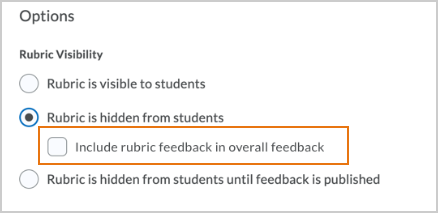
Figure: When you select the Rubric is hidden option, there is the option to include rubric feedback in overall feedback
| Impact of Change | Technical Details |
|---|---|
|
Slight disruption to administrators due to the new option to include feedback for hidden rubrics in general feedback. |
Availability: This feature is available to all clients using the updated Rubrics experience. To enable: This functionality is automatically available to updated Rubrics experience users. To turn on the updated Rubrics tool, ensure the d2l.Tools.Rubrics.CreateExperienceOptIn configuration variable is set to On or On (opt in). No further action is required. |
| Slight disruption to instructors who can provide feedback on hidden rubrics and have it appear as part of general feedback. | N/A |
New Content Experience - Workflow and performance improvements | Updated
Previously, in the New Learner Experience, using any widget that directed you to a module or topic, such as the Content Browser widget, when you completed the module or topic, you were always returned to the Table of Contents. Now, in the New Learner Experience, using any widget that directs you to a module or topic, when you complete the module or topic, you are returned to the homepage where you launched the New Learner Experience. This feature builds on a pattern introduced in learning paths and promotes consistency.
Building on improvements made to the Table of Contents in the May 2020/20.20.5 release, you will also observe a reduced Table of Contents load time and a more responsive experience while using the New Learner Experience.
| Impact of Change | Technical Details |
|---|---|
|
Slight impact to users due to the improvements made when using the New Learner Experience. |
Availability: This feature is available to all clients. To enable: Ensure the New Learner Experience is enabled in the New Content Experience. |
Roles and Permissions - Org Unit filtering | New
The ability to filter permissions by Org Unit has been added to the Edit Permissions page in Roles and Permissions. This update improves the load time of the page for organizations with many org units.
This feature partially implements PIE item D3686.
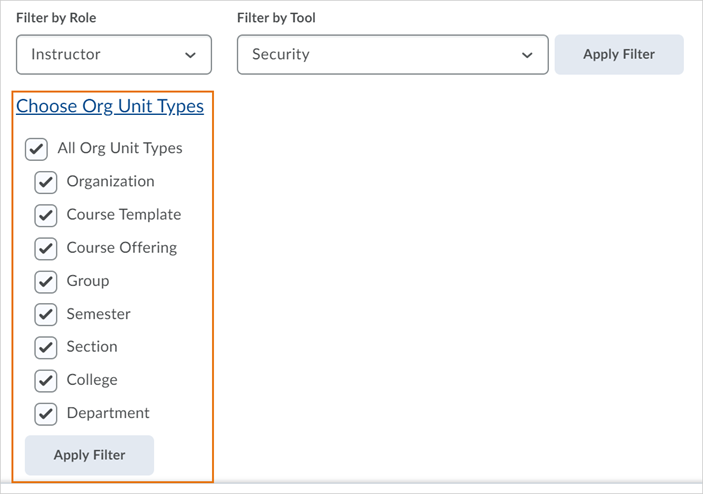
Figure: The new Choose Org Unit Types drop-down appears on the Edit Permissions page
| Impact of Change | Technical Details |
|---|---|
|
Slight impact to administrators due to the improved ability to search and filter permissions. |
Availability: This feature is available to all clients. To enable: This functionality is automatically enabled for Roles and Permissions users. No further action is required. |
Rubrics – Accessibility improvements in Rubric creation workflow | Updated
The following updates have been made to improve the accessibility of the rubric creation workflow:
- The button next to the page title is now labeled so a screen reader reads “Actions for [title]” when the button has the focus.
- The Overall Score now has the proper heading level so screen reader users can navigate directly to it from the heading list. Previously, users were required to tab through all previous headings in the list first.
- There is no longer a skipped heading level between Rubric Levels and Criterion (both level 3) and Standards (previously level 5).
- In the rubric preview window, Criterion Score has been added as a column header. Previously, the column did not have any header text.
| Impact of Change | Technical Details |
|---|---|
|
Slight disruption due to improved navigation. |
Availability: This feature is available to all clients using assistive technology with the updated Rubrics experience. To enable: This functionality is automatically available to updated Rubrics experience users. To turn on the updated Rubrics tool, ensure the d2l.Tools.Rubrics.CreateExperienceOptIn configuration variable is set to On or On (opt in). No further action is required. |
Widgets - My Courses and Updates widgets display unevaluated assignment submissions | New
The My Courses Widget and the Updates widget now display new, unevaluated assignment submissions instead of unread assignment submission files to instructors. This change aligns the widgets with the Assignments page and the Quick Eval tool to consistently notify users of unevaluated submissions and help them to track their work.
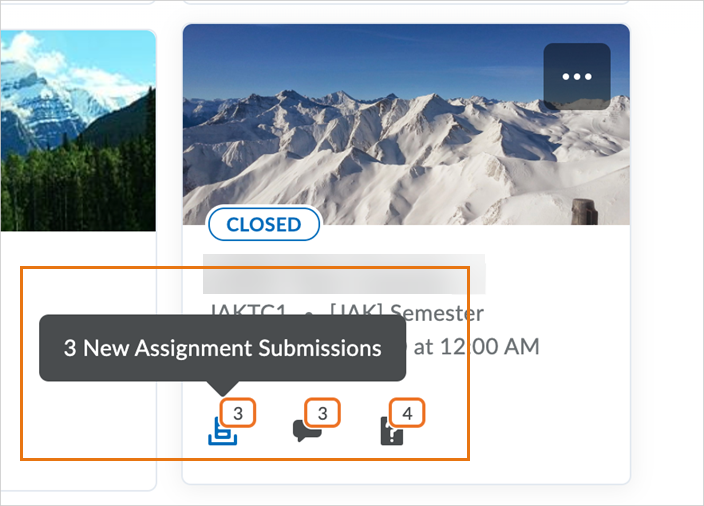
Figure: The My Courses widget displays unevaluated Assignments submissions
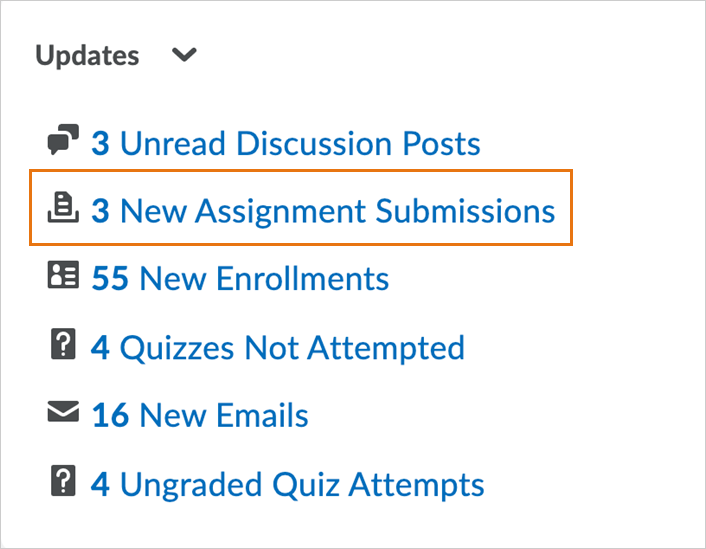
Figure: The Updates widget displays unevaluated Assignments submissions
| Impact of Change | Technical Details |
|---|---|
|
Slight impact to instructors due to the consistent count of unevaluated submissions in the My Courses and Updates widgets, and the Assignments and Quick Eval tools. |
Availability: This feature is available to all clients. To enable: This functionality is automatically enabled for My Courses and Updates widgets users. No further action is required. |
